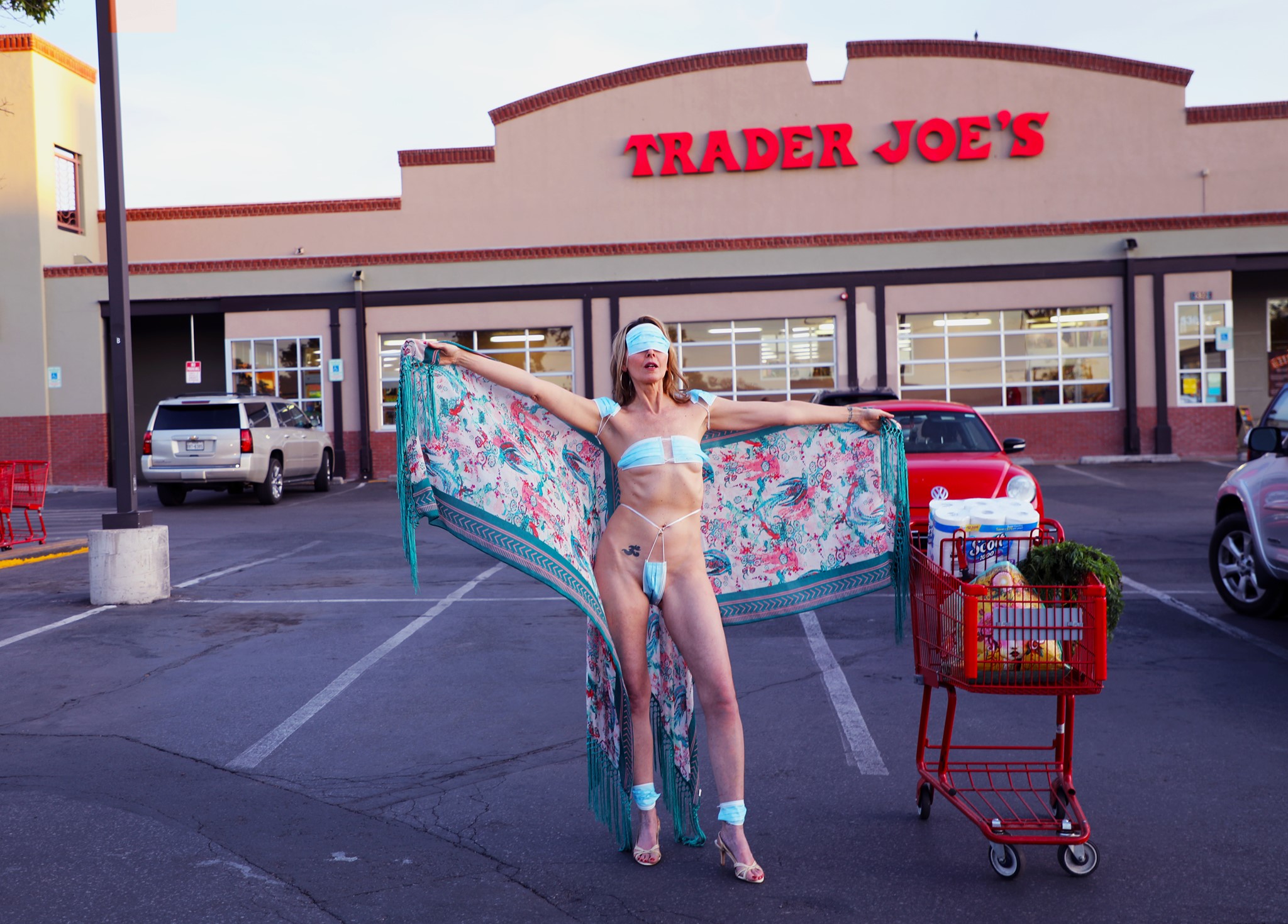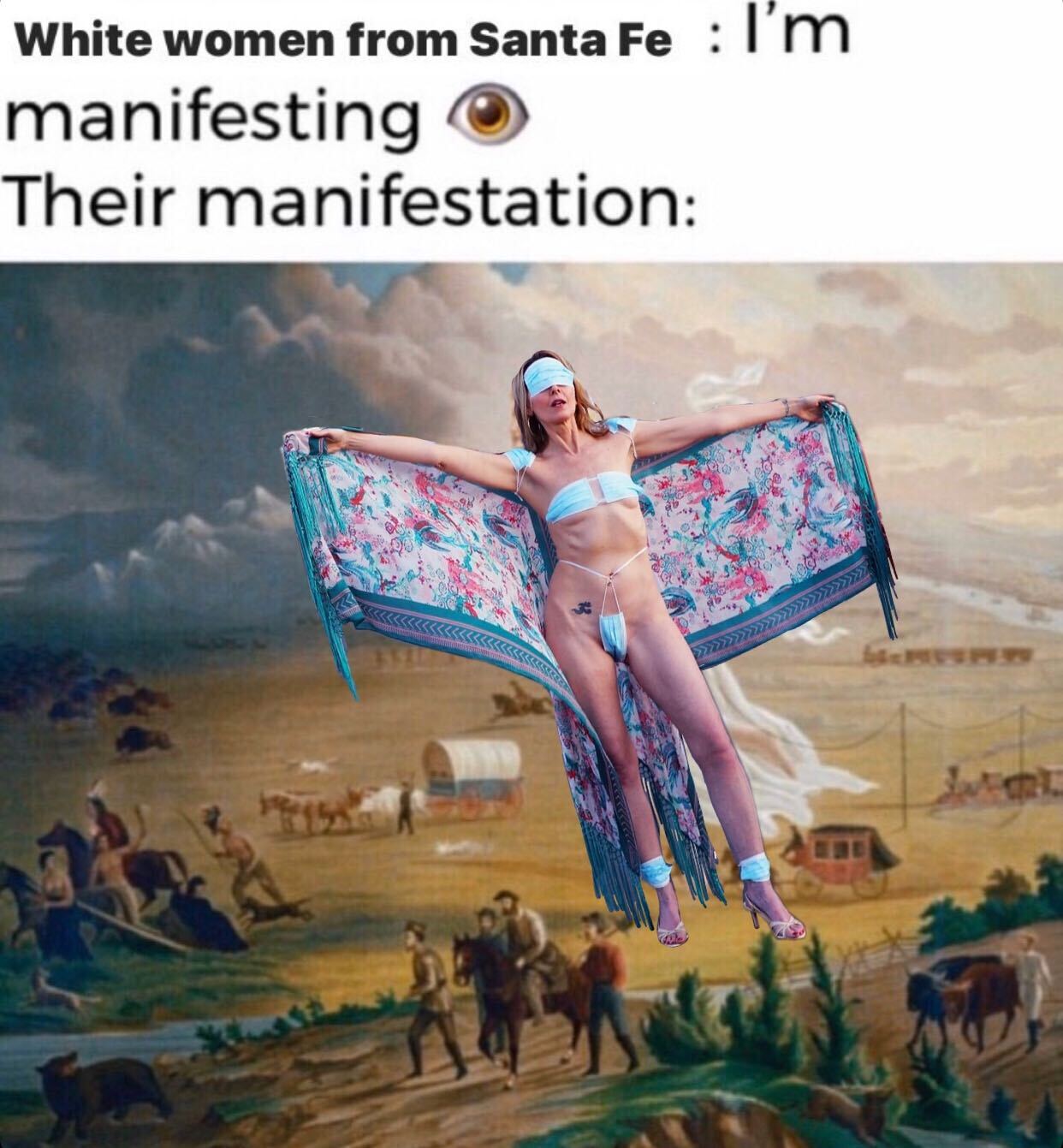Anti-Lockdown 'Artivism' Exploits Native Culture in the Liberal Mecca of Santa Fe

On May 22, 2020, DaVida Sal, a white woman who also calls herself a priestess of Isis (the Egyptian deity, not the terrorist organization), posted a series of pictures on Facebook featuring Julianne Parkinson wearing surgical masks on her crotch, breasts, shoulders and ankles. In one image, Parkinson, who is white as well, also sports a stick-on jewel bindi and a shawl. According to DaVida, this series was #artivism against the statewide order that masks must be worn in public.
Nevermind that this intervention wasted ten masks that could have been put to better use in Native communities, where COVID-19 has hit hardest. These photos are an insult to everyone personally affected by the pandemic—not to mention the front-line workers struggling to find PPE necessary for their work.
As would be expected in this national sacrifice zone where resource extraction has compromised the health of Native people for generations, the scale of the devastation from COVID-19 in Native communities is mind boggling. Tribal communities combined make up almost 60% of all positive COVID-19 cases in New Mexico, a state with a population of 2.1 million. 50% of all people who had died of COVID-19 in New Mexico by mid-May 2020 were Native American. As a group, New Mexico’s 23 tribes compose just 11% of the state population. The situation in the Navajo Nation is dire: over 5000 confirmed cases and almost 200 deaths.
Despite the dangers, people from all over the Southwest have come together to provide mutual aid to our most vulnerable populations. Our youth are working day and night to protect and care for our most important and beloved resource – our elders. They need PPE, water, food and other goods that are inaccessible to some on the rez, but not to two white women flaunting their privilege on social media.
This disgusting spectacle of monochromatic mutual masturbation is, sadly, all too common in the “City Different.” Santa Fe has evolved into a smoldering cesspool of white privilege, entitlement, cultural appropriation and racism adorned in faux adobe, concho belts, turquoise jewelry and expensive bikini waxes. I know; I live here.

Santa Fe has become a mecca for pseudo-spiritual, wannabe cultural cannibals disenchanted with their own morally and religiously bankrupt belief systems. They arrive in New Mexico drooling for peyote and Ayahuasca–seeking out anyone who could arrange for them a sweat lodge or vision quest. These yearners care nothing for the people whose culture they are appropriating. They wear appropriation like a hat to be cast aside when it’s time to go back to what they consider “normal” life.
Long ago, this area was home to Tewa-speaking people, who call it O’gha Po’oge, White Shell Water Place. Our ancestors built homes, farmed and raised families here. The sound of drums emanated from thriving villages where the Plaza and the Community Convention Center now stand. In 1680, our ancestors rose up in a bloody revolt against the colonizers who would deny us the right to live freely on our own land. That spirit of resistance continues to this day. It is our heritage. It is our mandate. This was once, and always will be, Native land. This is Tewa Territory.
Where were these two entitled white women, who so boldly demonstrated their privilege in front of Trader Joes, when an actual artist demonstrated what “artivism” looks like? When Diné artist Remy installed a series of wheat-paste murals on a wall along Old Pecos Trail in February 2020 depicting Palestinian women and children brutalized by the Israel Occupation Forces, where were these bindi-wearing priestesses of Isis?
“I become the subject I raise awareness for,” DaVida Sal commented on Facebook, “whether (it) is a Palestinian woman, a Mexican victim of death or violence or Syrian Refugee”. This statement captures white privilege: pretentiously appropriating victims of colonial violence in an attempt to promote her own “artistic” agenda. It appears that some “artivists” are only interested in exhibitionism and cultural cannibalism, not actual activism. And they’re never interested in placing those white bodies on the line for Indigenous/Brown/Black people’s struggle for liberation from settler-colonialism and US imperialism.
Santa Fe has evolved into a smoldering cesspool of white privilege, entitlement, cultural appropriation and racism adorned in faux adobe, concho belts, turquoise jewelry and expensive bikini waxes.
Native people being erased from our homelands is nothing new. From the very beginning of colonization, Native people in the Southwest have been reduced to what we can produce. During the era of Spanish conquistadors, it was for labor through the systems of repartimiento and encomienda. These institutions, enforced by the church and state, amounted to nothing more than slavery for Native people. With US hegemony came large-scale occupation of Native lands and the transformation of Native people into artists who could provide goods for the consumer market and creating the aesthetic of “Fanta Se” that exists today. The settler-colonial narratives require the appropriation of the Native aesthetic while Natives themselves have been completely erased. We must remain one-dimensional, voiceless, like the images in old Edward S. Curtis photographs. This is the ongoing genocide being perpetrated in bordertowns like Santa Fe.
These white women are playing the victim because they are ‘forced’ to wear masks in public. BIPOC, especially women, face much higher rates of physical and sexual violence. This appropriation of victimization further erases Indigenous people from our own struggles and instead centers white female bodies. At the same time, the sexualization of violence serves and upholds the settler narrative while ignoring the truth of violence against Indigenous/Brown/Black people. It also perpetuates the frontier mythology of regeneration through violence, while largely ignoring the effects of that violence on contemporary society.
In the United States, for example, Native American women are more than twice as likely to experience violence than any other demographic. Astonishingly, one in three Native women is sexually assaulted during her life, and 67% of these assaults are perpetrated by non-Natives. New Mexico is particularly lethal terrain, claiming the highest number of Missing and Murdered Indigenous Women in the country. Where are the white women “artivists” coming out to protest the murder and disappearance of Native women? White women in Santa Fe can protest having to wear a face mask in public by appearing nearly naked in front of a grocery store, but Native women cannot simply live without fear. Anywhere. Ever.
In Santa Fe, we don’t see these ‘artivists’ at protests or demonstrations. We don’t see them standing behind people of color, centering our voices, as allies. We don’t see them at all except as images on social media, or parading around Indian Market dripping silver and turquoise; commodifying Native culture with every step they take.

This is Santa Fe. Style without substance, fleeting and disingenuous. Not the spiritual mecca some believe it is, but a bordertown that masks its racist soul with art galleries, markets, faux adobe and fake turquoise. This is also O’gha Po’oge, a place where the righteous once rose up, defeated the forces of imperialism and restored harmony to the Tewa World.
We are here now. We have always been here. And we are rising again.





